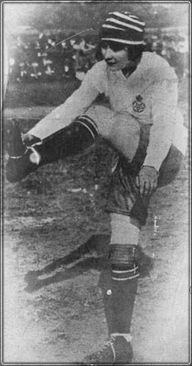by Libby Comyn
Football has a long and rich history which has seen it develop into the global game it is today. However, the turbulent history of women’s football often remains untold.
Women’s football has long since been the subject of many inequality and sexism debates due to it receiving a much lower profile, profit and support compared to its male counterpart. However, this hasn’t always been the case, and once upon a time women’s football pulled in bigger crowds than many male premier league teams receive today.
Women’s football had been established for a long time but it only really started to flourish in the 1920’s. During the First World War the football league suspended all its matches at the end of the 1914/15 season and so women filling in for male factory jobs also found themselves filling in for them on the pitch. Women working in the factories started informal ‘kick abouts’ during their breaks, which were then encouraged by their bosses as they saw it as a health benefit. As the war progressed, women’s football started to become more formalised and over 150 teams were formed from munition factories.
Initially the novelty of women playing football was used to raise money for war charities but the skill and commitment these women possessed quickly became apparent and so the matches started to become exciting and enjoyable events due to the ability of the women players.

Big teams like the Dick Kerr’s started to establish themselves as a highly respectable team, with their star player Lily Parr becoming a household name. Lily was the first female professional football player and racked in an incredible 1,000 goals during her 31 year career. In which time she was also a part of the first recognised international women’s football match against France, which England won 4-0. She was finally recognised for her footballing achievements in 2002 when she became the first women to be inducted into the National Football Museum’s hall of fame.

Women’s football went from strength to strength during the war. On Christmas Day of 1917 the Dick Kerr’s team held their first official match which brought in a crowd of over 10,000; the Munition Etters cup was then established the August of 1917. Just three years later the Dick Kerr’s played St. Helens ladies on Boxing Day 1920 to an incredible crowd of 53,000 with a further 14,000 locked outside at Everton’s Goodison Park ground. Currently in today’s 2015/6 male Premier League fixtures Everton’s highest attendance to a game is 39,951, which just goes to show the scale and popularity of women’s football at the time.

However their golden era was to be short lived as once the war was over, women found themselves quietly shunned back into domestic life while their game became overshadowed by the return and growth of the male game. The major blow to women’s football came on 5th December 1921 when the Football Association banned women from playing on FA affiliated pitched on the feeble grounds that “The game of football is quite unsuitable for females and ought not to be encouraged.”
Incredibly this ban was not lifted until 1971 after the formation of the Women’s Football Association in 1969 fought for the equal right to play. However it was years until women’s football got back on its feet and the ban is a large reason why women’s football lags behind the men’s game today.

The first TV coverage of women’s football was at the 1971 women’s FA Cup final, which was played at Crystal Palace national sports centre. Now just 44 years on, the most recent women’s FA Cup final was played at Wembley Stadium in front of a 30,719 crowd, which just goes to show the progression, resilience and passion of women’s football.
In recent years women’s football has made incredible progression. Sports England pledged to spend £30 million on developing women’s grassroots football with a focus on getting and keeping girls and women on the pitch. By 2014 football had the highest female participation of any sport in the UK with 2.6 million women and girls getting involved. This growth has then had a direct impact on the coverage of women’s football, which has always been lacking behind that of male football coverage. The 2012 women’s Olympic football final at Wembley saw a crowd of over 83,000 and the recent 2015 women’s World Cup was bigger and better than ever before, with the England vs Germany match attracting a crowd of 55,00. While the overall TV ratings of the women’s World Cup was an incredible 1,278,682.

Of course there is still a long way to go to match that of the male’s game but things are moving quickly in the right direction. Finally nearly 100 years later women are attracting the crowds and attention experienced by their predecessors. Those pioneering women achieved phenomenal success in a time it would have seemed impossible to do so, whilst they also changed the mind-set of a nation. It’s that determination, fire and passion that has been carried through years of women’s football that makes it such a special game and one that should most definitely not be undermined.

